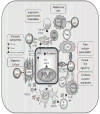Obstacles Posed by the Tumor Microenvironment to T cell Activity: A Case for Synergistic Therapies
- PMID: 28292435
- PMCID: PMC5423788
- DOI: 10.1016/j.ccell.2017.02.008
Obstacles Posed by the Tumor Microenvironment to T cell Activity: A Case for Synergistic Therapies
Abstract
T cell dysfunction in solid tumors results from multiple mechanisms. Altered signaling pathways in tumor cells help produce a suppressive tumor microenvironment enriched for inhibitory cells, posing a major obstacle for cancer immunity. Metabolic constraints to cell function and survival shape tumor progression and immune cell function. In the face of persistent antigen, chronic T cell receptor signaling drives T lymphocytes to a functionally exhausted state. Here we discuss how the tumor and its microenvironment influences T cell trafficking and function with a focus on melanoma, and pancreatic and ovarian cancer, and discuss how scientific advances may help overcome these hurdles.
Keywords: T cell dysfunction; TME; adoptive T cell therapy; genetic engineering; immunotherapy; tumor microenvironment.
Copyright © 2017 Elsevier Inc. All rights reserved.
Figures



References
Publication types
MeSH terms
Substances
Grants and funding
LinkOut - more resources
Full Text Sources
Other Literature Sources
Molecular Biology Databases

